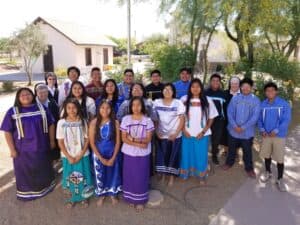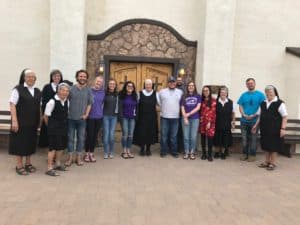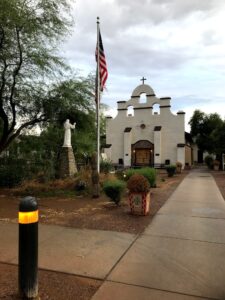The Diocese of Phoenix featured St. Peter Mission Catholic School on Together Let Us Go Forth digital magazine in honor of their Centennial Celebration. See the coverage on p. 16-19 here. Joyce Coronel is a writer for Together Let Us Go Forth – Juntos Sigamos Adelante.
The 200 students at St. Peter Indian Mission Catholic School quietly file into the chapel and take their places. Each of them wears a brightly colored shirt with three words inscribed on the back: Respect, Reverence, Responsibility. “They’re Gospel values. They’re foundational values for our culture, the Native culture, and the Gospel,” says Sister Martha Mary Carpenter, OSF, principal of the school. She sits in the very last pew near the door as the students begin the prayer service prior to heading home. Each day at the school begins and ends in the humble chapel that features two paintings from scenes of the life of St. Peter. Sister Martha doles out comments and advice like any good mother would as the children leave the chapel 15 minutes later: “Remember to bring home the letter.” “Happy birthday!” “Jewelry? You’re pretty enough without it.” Some of the younger children stop at the doorway to lean in to give Sister Martha a hug. “They’re our children,” Sister Martha says. She’s godmother to many in the community and has served 37 years at St. Peter’s. “Chances are, if you’re sitting in my classroom, so was your grandfather.”
Sister Pamela Catherine Peasel, OSF has taught at St. Peter’s for 12 years. She entered the Franciscan Sisters of Christian Charity in 2008 and has only ever served at St. Peter’s. In the fall, Sister Pamela will lead the new St. Peter High School, but for now, she teaches the junior high girls. Sister Martha teaches the junior high boys. The school started separating junior high boys from girls about 25 years ago, Sister Martha says. She remembers what it was like before. “All a boy would have to do was look at the girl and she’d do his homework.” “I think they’re more relaxed, too, in both rooms, too, to answer questions and ask questions and have conversation. They’re not intimidated by each other,” Sister Pamela adds.
An intergenerational school
Angelita Kyyitan White, office manager, has spent a lifetime in this remote village in the Gila River Indian Community. She’s a graduate of St. Peter’s, and her family has been heavily involved with the school over the last several decades. One of her daughters works in the kitchen, and she has grandchildren and great-grandchildren who attend the school, founded in 1923. “My parents sent us here because it was closer and was walking distance. We lived across the road, me and my seven brothers. I’m the youngest.”All five of her own children graduated from St. Peter’s. Tragically, two of them were lost to violence, shot and killed in separate incidents. Her husband died two years ago. The Franciscan sisters taught White respect and the power of prayer, she says. “After losing two of my kids and my husband, I wouldn’t have made it without prayer.”
 Andrea Terry graduated from St. Peter’s in 1970. Like Angelita, she remembers when there were no lay teachers, only religious sisters. She’s enthusiastic about the year-long celebration of the school’s centennial. “I’m excited to see how it’s going to work out, you know? There will be people coming from way back,” Terry says. She acknowledges the stark challenges facing the community. “Drugs and alcohol, meth. It’s really bad here. Shootings. Violence,” Terry says. Most students are being raised by grandparents as their parents are out of the picture. And yet, this little enclave known as St. Peter’s Indian Mission Catholic School provides an oasis of sorts for the students and their families. Tuition is paid via a mix of scholarships, CDA grants, tuition organizations, donations, and tribal funding from the Tribal Allocation and Alcohol Tax Grant. One hundred percent of the student body is Native American, with most belonging to the Gila River Indian Community. Some are half-Apache or half-Hopi, White says.
Andrea Terry graduated from St. Peter’s in 1970. Like Angelita, she remembers when there were no lay teachers, only religious sisters. She’s enthusiastic about the year-long celebration of the school’s centennial. “I’m excited to see how it’s going to work out, you know? There will be people coming from way back,” Terry says. She acknowledges the stark challenges facing the community. “Drugs and alcohol, meth. It’s really bad here. Shootings. Violence,” Terry says. Most students are being raised by grandparents as their parents are out of the picture. And yet, this little enclave known as St. Peter’s Indian Mission Catholic School provides an oasis of sorts for the students and their families. Tuition is paid via a mix of scholarships, CDA grants, tuition organizations, donations, and tribal funding from the Tribal Allocation and Alcohol Tax Grant. One hundred percent of the student body is Native American, with most belonging to the Gila River Indian Community. Some are half-Apache or half-Hopi, White says.
Sister Barbara Jean Butler, OSF helps connect school families with community resources. Five buses transport the children to St. Peter’s on weekday mornings, often picking up students while it’s still dark. They arrive on campus at 7:15 a.m. and head straight for the chapel. Their Native culture is an important facet of their overall education, and the students pray and sing songs in their Native language. Culture classes reinforce their him-dag, or way of life. St. Peter’s started teaching Native culture in 1985, 15 years before the tribal government mandated it for all schools on the reservation. “The kids treasure their culture. The worst thing I can say to my boys is, ‘OK, you keep that up, and you’re not having culture class!’” Sister Martha says. “Then they shape up. We have people who teach the language, the songs and the dances, the legends, and the foods. It’s wonderful.”
Pandemic hardships
 One of the major challenges the school faces, says Sister Martha, has been the two-and-a-half-year forced closure of the school during the pandemic. St. Peter’s is still not fully open, so volunteers aren’t able to help out in the classroom. Then there’s the learning gap. “The most challenging part was with our babies. Kindergarten, first, second and third graders had never been in school. The third graders were here for like six months of kindergarten and then, in March of 2020, were gone,” Sister Martha says. Unlike a lot of other schools, St. Peter’s did not automatically promote students to the next grade level. In fact, about 70 children were held back.“Our little ones, they came to school and knew nothing about lining up, taking their place,” Sister Martha says. “My kindergarten teacher, who was an excellent teacher, almost lost her mind because this was the first class she had that did not have preschool.”The sisters could tell that many of the students had never been inside of a church. “They’ve suffered academically but also in their faith,” Sister Pamela says. “So, it’s teaching them how to pray again and just talk to God.”The sisters have turned to the Franciscan Friars of the Holy Spirit (FHS), a community of religious priests who tend to the spiritual needs of Native Americans spread throughout numerous missions in the Diocese of Phoenix. Father Antony Tinker, FHS and Father Peter Teresa McConnell, FHS take turns saying Mass Tuesday through Friday at St. Peter’s at 7:45 a.m. The Masses, Sister Martha says, also serve to instruct and form students in the faith. “They’ve done a beautiful job,” Sister Martha says.
One of the major challenges the school faces, says Sister Martha, has been the two-and-a-half-year forced closure of the school during the pandemic. St. Peter’s is still not fully open, so volunteers aren’t able to help out in the classroom. Then there’s the learning gap. “The most challenging part was with our babies. Kindergarten, first, second and third graders had never been in school. The third graders were here for like six months of kindergarten and then, in March of 2020, were gone,” Sister Martha says. Unlike a lot of other schools, St. Peter’s did not automatically promote students to the next grade level. In fact, about 70 children were held back.“Our little ones, they came to school and knew nothing about lining up, taking their place,” Sister Martha says. “My kindergarten teacher, who was an excellent teacher, almost lost her mind because this was the first class she had that did not have preschool.”The sisters could tell that many of the students had never been inside of a church. “They’ve suffered academically but also in their faith,” Sister Pamela says. “So, it’s teaching them how to pray again and just talk to God.”The sisters have turned to the Franciscan Friars of the Holy Spirit (FHS), a community of religious priests who tend to the spiritual needs of Native Americans spread throughout numerous missions in the Diocese of Phoenix. Father Antony Tinker, FHS and Father Peter Teresa McConnell, FHS take turns saying Mass Tuesday through Friday at St. Peter’s at 7:45 a.m. The Masses, Sister Martha says, also serve to instruct and form students in the faith. “They’ve done a beautiful job,” Sister Martha says.
Abounding hope
The future is full of hope as the two sisters look toward the 2023-2024 academic year. Rather than children being bussed over to Chandler High School or Casa Grande Union High School, they’ll have the option to attend the new St. Peter’s High School led by Sister Pamela. “Our school is going to be small, like 20-25 per grade level,” Sister Pamela says. Students will learn in modular classrooms until regular classrooms can be built on a campus field. “We’re partnering again with Shea Homes. They have blessed us so much,” Sister Martha says. The home builder constructed the $4 million preschool, remodeled the kitchen and cafeteria, added a new classroom building, and installed new fencing, landscaping, and a play area. The Franciscan Friars spend every Wednesday at the school and will be teaching at the new high school when it opens, Sister Martha says. “We’re going to have sisters teach, too.” The late Major League Baseball player and announcer Joe Garagiola was also a major supporter of the school, so much so that an elder and medicine man gave him an honorary Native moniker: Awesome Fox. The baseball field at the school is named Awesome Fox Field in his honor and students regularly recite “Joe’s Prayer,” keeping his legacy alive. At a Feb. 11 Mass celebrating St. Peter’s centennial, Father Tinker extolled the many sacrifices of the Franciscan Sisters of Charity through the years. “We turn to the sisters, we turn to those who have come before us, who are the reason we are here today, and we thank them for all they did, the sacrifices they made,” Father Tinker said. “The school would not have been here for 100 years if so many had not given so much of themselves.”

Recent Comments